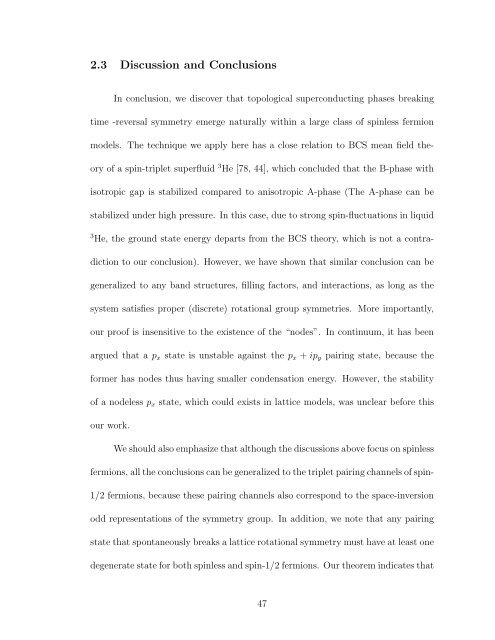ABSTRACT - DRUM - University of Maryland
ABSTRACT - DRUM - University of Maryland
ABSTRACT - DRUM - University of Maryland
Create successful ePaper yourself
Turn your PDF publications into a flip-book with our unique Google optimized e-Paper software.
2.3 Discussion and Conclusions<br />
In conclusion, we discover that topological superconducting phases breaking<br />
time -reversal symmetry emerge naturally within a large class <strong>of</strong> spinless fermion<br />
models. The technique we apply here has a close relation to BCS mean field theory<br />
<strong>of</strong> a spin-triplet superfluid 3 He [78, 44], which concluded that the B-phase with<br />
isotropic gap is stabilized compared to anisotropic A-phase (The A-phase can be<br />
stabilized under high pressure. In this case, due to strong spin-fluctuations in liquid<br />
3 He, the ground state energy departs from the BCS theory, which is not a contradiction<br />
to our conclusion). However, we have shown that similar conclusion can be<br />
generalized to any band structures, filling factors, and interactions, as long as the<br />
system satisfies proper (discrete) rotational group symmetries. More importantly,<br />
our pro<strong>of</strong> is insensitive to the existence <strong>of</strong> the “nodes”. In continuum, it has been<br />
argued that a p x state is unstable against the p x + ip y pairing state, because the<br />
former has nodes thus having smaller condensation energy. However, the stability<br />
<strong>of</strong> a nodeless p x state, which could exists in lattice models, was unclear before this<br />
our work.<br />
We should also emphasize that although the discussions above focus on spinless<br />
fermions, all the conclusions can be generalized to the triplet pairing channels <strong>of</strong> spin-<br />
1/2 fermions, because these pairing channels also correspond to the space-inversion<br />
odd representations <strong>of</strong> the symmetry group. In addition, we note that any pairing<br />
state that spontaneously breaks a lattice rotational symmetry must have at least one<br />
degenerate state for both spinless and spin-1/2 fermions. Our theorem indicates that<br />
47
















